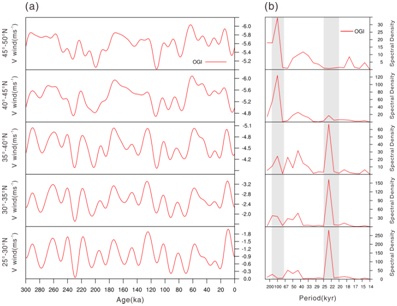The East Asian winter monsoon (EAWM) system is an important component of the global climate system. Anomalies in the EAWM can result in abnormal weather and climate. Meanwhile, EAWM has significant climatic variations over a range of time-scales from interannual to orbital.
Numerous geological records have preserved the EAWM's variations at orbital time scales. The Chinese loess records indicated a dominant EAWM period of 100-kyr, while marine sediments in the South China Sea suggested that the EAWM has a significant period of 23-kyr.
The latitudinally different responses of Chinese loess records in mid-latitude and sedimentary records in the lower latitude South China Sea show distinct latitude dependence of EAWM.
Recently, Dr. LIU Xiaodong from Institute of Earth Environment (IEE) of the Chinese Academy of Sciences and his colleagues made new progress in the study of latitude dependence of EAWM variations at orbital scale.Long-term transient simulations for the last 300,000 years indicated that the variations of the EAWM at orbital scales showed significant periodicity, and the periodicity was distinct for the northern and southern EAWM.
The dominant period in the southern (23-kyr period) was tied to precession-dominated orbital insolation variations while the northern EAWM was affected strongly by glacial cycles on a 100-kyr period (Fig.1).
Through comparisons of three transient experiments with different combinations of forcings, the researchers isolated the impact of orbital insolation from its combined effects with ice-sheet cycles.
When the boreal winter insolation reached a minimum, the surface air temperature over East Asia (especially at subtropical latitudes) decreased much more than the surface air temperature did over the adjacent western Pacific, thus enhancing the zonal land-sea thermal contrast and driving a stronger northerly flow into the southern EAWM (Fig.2a and 2b).
In response to glacial-interglacial cycles on longer timescales (100-kyr), the extensive ice sheets over North America and Northern Europe induced a powerful anticyclonic circulation anomaly above them and forced a strong cyclonic circulation anomaly over the adjacent northern Pacific (deepening the Aleutian low).The cyclonic circulation anomaly in the northern Pacific further strengthened the northerly flow into the northern EAWM (Fig.2c and 2d).
Meanwhile, the different responses of southern and northern EAWM to orbital insolation and ice-sheet forcings can further lead to in phase or out phase variations between the southern and northern EAWM.
This work was published in Geophysical Research Letters.

Fig.1 Time series (a) and the corresponding power spectra (b) of the EAWM indices for five 5-degree latitude bins over East Asia (25°-50°N and 105°-125°E)in the full-forcing experiment. The EAWM index is defined as the area-mean meridional wind speed at 850hPa for each latitude bin. (Imaged by XIE Xiaoxun, et al.)

Fig.2 Composite differences for winter (DJF) surface air temperature (shaded)and 850hPa wind vectors between the low and high NHWI (January insolation at 30°N) periods in the O (a) and OGI (b)experiments. Composite differences for winter (DJF) geopotential height (shaded) and wind vectors at 600hPa(c) and 850hPa (d) between the glacial periods and interglacial periodsin the OGI experiment. (Imaged by XIE Xiaoxun, et al.)
 © 2015 Institute of Earth Environment,CAS
© 2015 Institute of Earth Environment,CAS Address:No. 97 Yanxiang Road, Xi'an 710061, Shaanxi, China

 Location :
Location :